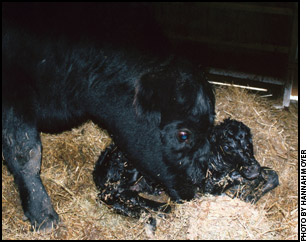 Calving 2010
Calving 2010
Calving season proves challenging for some producers in 2010.
Exceptionally cold weather made the 2010 calving season tougher than the last several years for many beef producers, said Ron Lemenager, Purdue Extension beef specialist.
Many calves were born with heavier birth weights, which resulted in more cases of dystocia, or difficult birth, in some herds.
"In a cold environment, cows shunt some blood flow away from their extremities to the internal organs in an attempt to maintain core body temperature," Lemenager explained. "When this happens, there is not only an increase in blood flow, but also an increase in nutrient flow to the pregnant uterus and developing fetus. The fetus grows faster in response to the increased nutrient availability, and we observe higher calf birth weights."
Feeding excess protein to cows during late gestation is another factor that can increase birth weights and the chance of dystocia. Significantly overfeeding protein can occur when feeds such as high-quality alfalfa hay are the primary forage or when cows are fed high levels of distillers' grains or corn gluten, Lemenager said.
In an ongoing Purdue study, cows were fed dry distillers' grains with solubles (DDGS) to supply all of the protein and majority of the cows' energy needs during the last trimester of gestation. Compared with the control diet, the DDGS diet provided equal energy but nearly double the required protein. Both calf birth weights and incidences of dystocia were significantly increased.
Heavier birth weights not only contribute to more dystocia, they also can result in lethargic, less vigorous calves that are slower to find the udder. This slowness is typically associated with oxygen deprivation resulting from a prolonged, difficult delivery.
 "Even when these calves are presented normally, with the head and front feet exposed, the umbilical cord can be compromised and oxygen flow from the dam to the fetus can be restricted before the calf is capable of breathing normally on its own," Lemenager said. "These calves typically need to be fed colostrum by esophageal feeder within six hours of delivery to not only provide passive immunity, but to provide essential energy."
"Even when these calves are presented normally, with the head and front feet exposed, the umbilical cord can be compromised and oxygen flow from the dam to the fetus can be restricted before the calf is capable of breathing normally on its own," Lemenager said. "These calves typically need to be fed colostrum by esophageal feeder within six hours of delivery to not only provide passive immunity, but to provide essential energy."
Cold weather also contributes to dystocia by affecting the cow's body condition. With a colder-than-normal winter, cows in some herds might have been thinner than normal. Thin cows can have a higher incidence of dystocia, retained placentas and lower colostrum quality.
Dystocia can increase the number of retained placentas, and both can affect a cow's reproductive performance during the following breeding season.
[Click here to go to the top of the page.]





